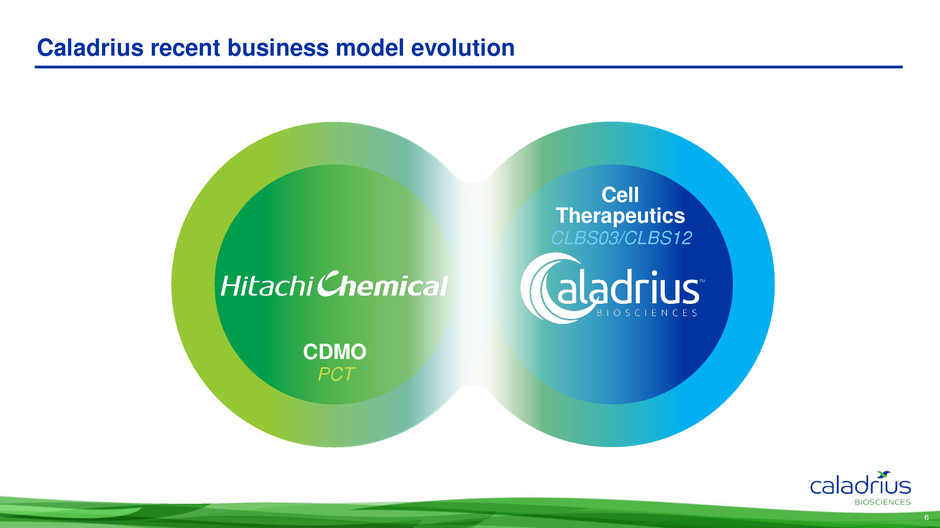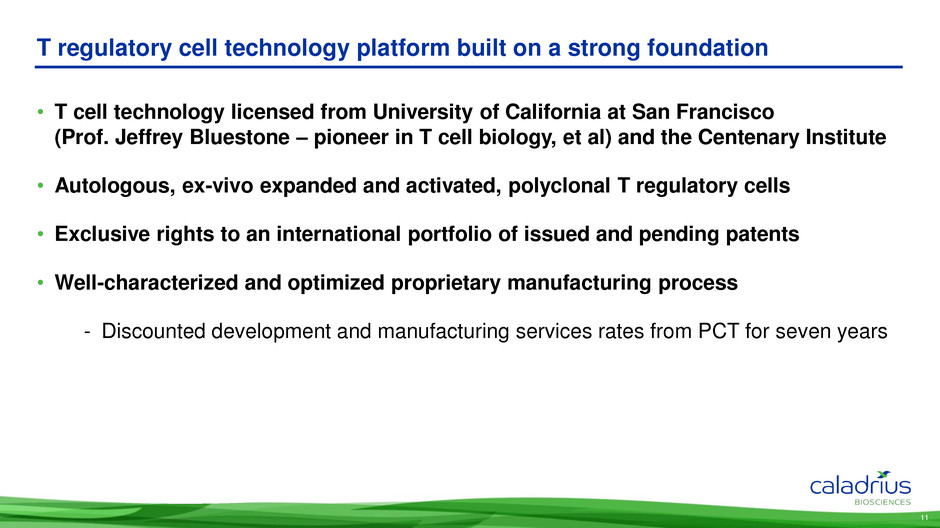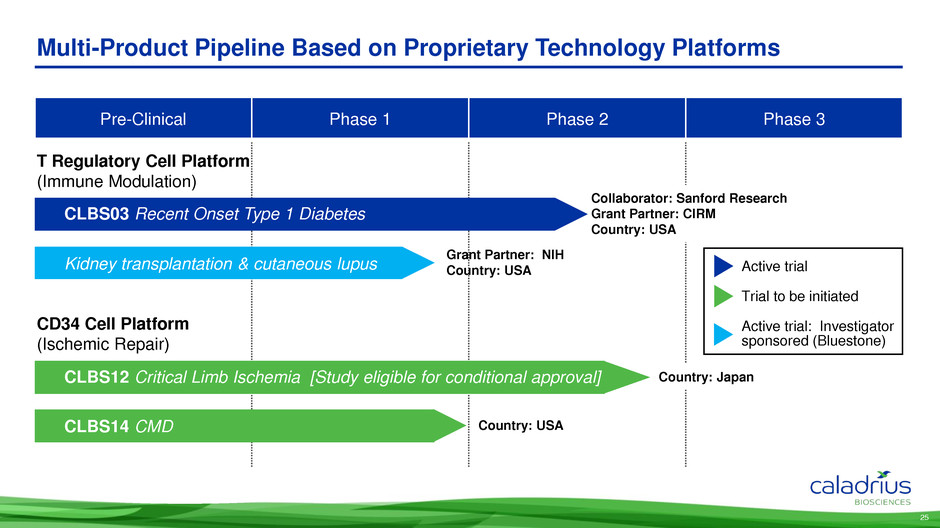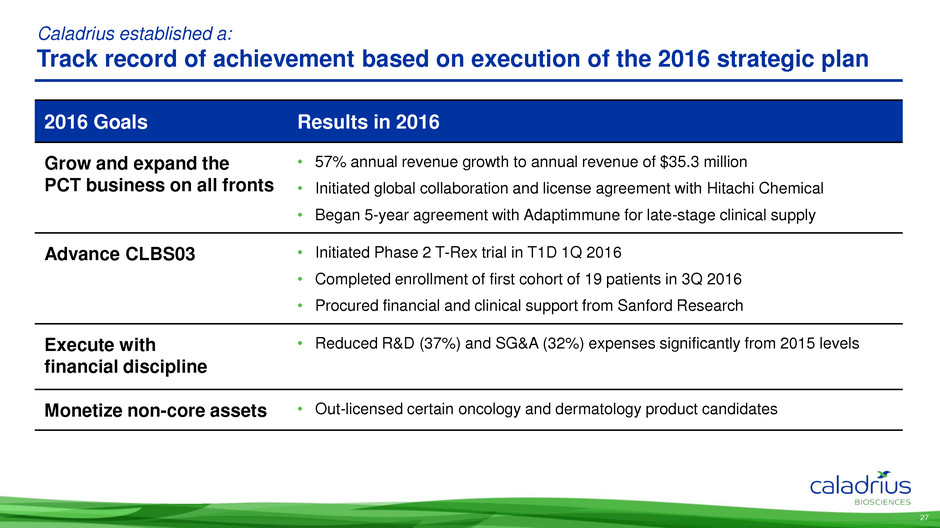Attached files
| file | filename |
|---|---|
| 8-K - 8-K 06.05.17 CORPORATE PRESENTATION - CALADRIUS BIOSCIENCES, INC. | a8-k060517corporatepresent.htm |

Corporate Presentation
David J. Mazzo, PhD
Chief Executive Officer
June 2017 | NASDAQ: CLBS

Safe Harbor for forward-looking statements advisory
This Investor Presentation contains forward-looking statements within the meaning of Private
Securities Litigation Reform Act of 1995. Forward-looking statements reflect management’s
current expectations, as of the date of this presentation, and involve certain risks and
uncertainties. All statements other than statements of historical fact contained in this Investor
Presentation are forward-looking statements. The Company’s actual results could differ
materially from those anticipated in these forward-looking statements as a result of various
factors. Factors that could cause future results to differ materially from the recent results or
those projected in forward-looking statements include the “Risk Factors” described in the
Company’s Annual Report on Form 10-K filed with the Securities and Exchange Commission
(“SEC”) on March 17, 2017, and in the Company’s other periodic filings with the SEC. The
Company’s further development is highly dependent on, among other things, future medical
and research developments and market acceptance, which are outside of its control. You are
cautioned not to place undue reliance on forward-looking statements, which speak only as of
the date of this Investor Presentation. Caladrius does not intend, and disclaims any obligation,
to update or revise any forward-looking information contained in this Investor Presentation or
with respect to the matters described herein.
2

Caladrius transforms cells into therapies
3

Caladrius historical hybrid business model
4
Cell
Therapeutics
CLBS03/CLBS12
CDMO
PCT

Caladrius recent business model evolution
5
Cell
Therapeutics
CLBS03/CLBS12
CDMO
PCT

Caladrius recent business model evolution
6
Cell
Therapeutics
CLBS03/CLBS12
CDMO
PCT

Cell
Therapeutics
PCT
CDMO
Caladrius business model evolution – two healthy companies emerge
7

Cell
Therapeutics
Caladrius unlocks PCT value and preserves intimate working relationship
8
Capital for Growth
Cell
Therapeutics
PCT
CDMO

Caladrius Biosciences: Focused, funded and poised for growth
• Pure-play clinical stage therapeutics development company
• Two technology platforms on which to build
- T regulatory cells for immune modulation
- CD34+ cells for ischemic repair
• Well-funded with cash of ~$70 million
• Debt-free
• On-going landmark phase 2 study of CLBS03 in recent onset type 1 diabetes
- Strategic relationship with Sanford Research (CLBS retains all product rights)
- ~$12.2 million California Institute for Regenerative Medicine (C.I.R.M.) grant awarded
- ~$600,000 Juvenile Diabetes Research Foundation (JDRF) grant to Benaroya as direct CLBS03 study subsidy
• Phase 2 protocol in Critical Limb Ischemia for CLBS12 ready to initiate in Japan
- Positive results should qualify product for early conditional approval in Japan
9

Immune Modulation
Autologous, polyclonal T regulatory cells
10

T regulatory cell technology platform built on a strong foundation
• T cell technology licensed from University of California at San Francisco
(Prof. Jeffrey Bluestone – pioneer in T cell biology, et al) and the Centenary Institute
• Autologous, ex-vivo expanded and activated, polyclonal T regulatory cells
• Exclusive rights to an international portfolio of issued and pending patents
• Well-characterized and optimized proprietary manufacturing process
- Discounted development and manufacturing services rates from PCT for seven years
11

T Regulatory Cells (Tregs):
Restoring immune balance and function
• Deficiency in number or function of Tregs vs. T effector cells manifests as
autoimmune disease
• Augmentation of number/potency of Tregs is intended to restore the immune system
to its “native” state and reduce/eliminate autoimmune disease symptoms
12
1 Normal immune system:
immune balance
2 Autoimmunity:
immune imbalance
3 Infusion of Tregs:
balance restored
T regulatory cells T effector cells Natural polyclonal T regulatory cells

Polyclonal T regulatory cell therapy is potentially applicable across multiple
autoimmune, alloimmune and allergic diseases, many qualifying as orphan
13
Combined markets represent a multi-billion dollar opportunity:
1. Global Patient numbers include total patients from US, EU and Japan only.
2. Annual incidence of type 1 diabetes for patients <15 years old. IDF Diabetes Atlas, 7th Edition.
Recent-Onset
Type 1
Diabetes
Neuromyelitis
Optica (NMO)
Uveitis Cutaneous
Lupus
Graft-versus-
host Disease
(GVHD)
Kidney
Transplant
Scleroderma SLE - Lupus
Global
Patients1
86,0002 13,930 254,869 1,993,080 12,529 3,123 165,537 553,968
Clinical
Study
Endpoints
C-peptide,
insulin use
EDSS,
visual acuity
Response rates CLASI,
Skindex-29
GHVD-free
survival
Failure rates mRSS,
CRISS,
sHAQ
BILAG,
SELENA-
SLEDAI
Biomarkers C-peptide,
others
NMO-IgG
antibody
N/A Cell type
analysis
N/A Renal function Cytokines,
B cells
B cell counts
Additional potential indications:
Lupus Nephritis • Steroid resistant asthma • Rheumatoid arthritis • Multiple sclerosis • Bullous pemphigoid • Crohn’s Disease

Simple, cost-effective, proprietary
Manufacturing process is scalable and economically viable
• Simple and efficient clinical manufacturing process:
- Simple, minimally intrusive cell collection process (whole blood or, eventually, apheresis)
- Reliable and well-characterized cGMP process
- Extremely high Phase 2 manufacturing success rate to date
- Introduction of apheresis and cryopreservation step(s) are expected to be likely
1 Day 1: Patient blood draw
or apheresis (future)
3 Day ~14: Infusion of Treg
therapy to same patient
Collection Processing Infusion
2 Day 2: Treg isolation,
activation & expansion
14

CLBS03: Recent onset type 1 diabetes program overview
• Ongoing landmark Phase 2 clinical study in T1D (T-Rex trial)
- C.I.R.M. grant for up to $12.2 million based on specified milestone achievement
- JDRF grant to Benaroya Research Institute to conduct extensive immune profile (study cost offset)
- DSMB satisfactory assessment of safety of initial cohort achieved ahead of schedule
- Final cohort enrollment underway
• Strategic collaboration with Sanford Research
- $5 million equity investment
- Providing operating support for trial and clinical sites
• International regulatory recognition
- FDA Fast Track designation – First time granted to a T1D program
- FDA Orphan designation
- EU ATMP (Advanced Therapeutic Medicinal Product) classification
15

T Regulatory Cell (Tregs) therapy offers:
An attractive medical and commercial opportunity for T1D
• Each year >18,000 newly diagnosed patients under 20 years of age in US1;
3% CAGR worldwide2
• No curative treatments, only lifelong insulin therapy (often with serious co-
morbidities)
• Preserving remaining beta cell function in recent onset patients is
expected to slow/stop disease progression and lead to long-term medical
and pharmaco-economic benefits3
1. National Diabetes Statistic Report, 2014
2. Maahs DM, et al. Endocrinol Metab Clin North Am. 2010
3. Nathan DM, et al. Arch Intern Med. 2009
16

CLBS03 occupies a unique position in the type 1 diabetes treatment paradigm
17
Chronic blood glucose
management
Disease Modification
(CLBS03)
Function regeneration
Approach Symptom management Reduce or eliminate
disease progression;
potentially “curative”
Replace depleted cells/organs
producing insulin; potentially
“curative”
Insulin
Impact
Improve therapeutic
effect and/or efficiency of
delivery of insulin/analogs
Avoid or reduce need
for insulin by preserving
active beta cells
Avoid or reduce need
for externally-sourced insulin by
providing new beta cells
Availability Currently available with
more in development
Currently in
Phase 2 trial
Many years of
development remaining

US Study1 EU Study2
Dose 4-dose escalation cohorts
(0.05 x 108 to 26 x 108 cells)
1 infusion (10 or 20 million cells/kg) or
2 infusions (30 million cells/kg total)
Patients 14 adult patients with established T1D 22 patients aged 5-18 with T1D
Results • Demonstrated safety/tolerance
- No cytokine release, infectious complications
or infusion reactions observed
- >500 fold dose range tested
• Established manufacturing feasibility
- Can produce expanded Treg cell population
with enhanced functionality
• Implied durability of effect
- Infused Tregs were stable and detectable
in peripheral circulation for 1 year
At 12 months:
• 6 treated patients achieved remission3
• 2 treated patients achieved insulin independence
Published Phase 1 studies demonstrated Treg cell therapy to be:
Well tolerated1,2, durable1
and preserving of beta cell function in children2
1. Bluestone, et al. Science Translational Medicine 2015
2. Marek-Trzonkowska, N et al. Clinical Immunology 2014
3. Remission Definition: Daily dose of insulin ≤ 0.5 UI/kg body weight & fasting c-peptide > 0.5 ng/ml at 12 months after recruitment
0
0.2
0.4
0.6
0.8
1
1.2
M
e
a
n
C
-p
e
p
ti
d
e
(n
g
/m
l)
Fasting C-peptide levels stabilized
One
Year
Control, n=10
Treatment, n=12
Day 0 Month 4
18

T-Rex Study:
Phase 2 trial in adolescents with T1D initiated in March 2016
19
Rigorous Design
• Double-blind, placebo-controlled, randomized (1:1:1) trial
• Adolescent patients ages 8 to <18 with recent-onset (diagnosed within last 100 days) T1D
Standard Endpoints
• Preservation of C-peptide level, insulin use, severe hypoglycemic episodes, glucose
and hemoglobin A1c levels
Study Size • 111 patients enrolled across ~12 study sites in the USA
Power • 80% power to detect a 0.2 pmol/mL difference in AUC mean C-peptide between active and placebo
Study Execution • Strategic collaboration with Sanford Research providing operational resources and capital
Treatment • Single infusion of CLBS03 (dose cohorts of 2.5 or 20 million cells/kg) or placebo infusion (control)
For more details: NCT02691247 at www.clinicaltrials.gov

2019
T-Rex Study:
Timeline including near-term milestones
20
• Last (111th)
patient randomized
• 6-month follow-up
of 50% of subjects
• 50% of
subjects treated
• 70th subject
enrolled
Interim Analysis of Early
Therapeutic Effect
Topline Data:
Primary Efficacy Endpoint
1 year Analysis
2016
Study initiation in
March 2016
2017 2018 1Q 2Q 3Q 4Q 1Q 2Q 3Q 4Q

Ischemic Repair
CD34+ cells
21

CD34 cell therapy is supported by a profound body of clinical evidence
• CD34 cells have been investigated in clinical studies encompassing >700 patients
- Pre-clinical studies document improved microcirculation1
- Phase 2 clinical studies consistently show benefits in safety and function
o Reduced amputation in critical limb ischemia2
o Improved function in claudication3
o Reduced angina and improved ETT in refractory angina4
o Improved mortality and LVEF in dilated cardiomyopathy5
• Opportunities exist across multiple underserved cardiovascular indications
- Critical limb ischemia (CLI) in Japan
- Coronary microvascular dysfunction (CMD)
- Refractory angina
22
1. Kalka et al. PNAS. 2000; Schatteman et al. J Clin Invest 2000.; Madeddu et al. FASEB. 2004.
2. Losordo et al. Circ Cardiovasc Interv 2012.
3. From US study (n=17); Not yet published
4. Losordo et al. Circ Res 2011.; Povsic et al. JACC Cardiovasc Interv. 2016.
5. Vrtovec et al. Circ Res 2013.

23
Design
• Prospective, open label, controlled, randomized trial
• Patients with no-option CLI
Advantageous
Primary Endpoint
• Time to continuous CLI-free status (defined as 2 consecutive monthly visits)
Study
Size
• 35 patients enrolled across multiple centers in Japan
Treatment • Up to 106 autologous G-CSF-mobilized peripheral blood-derived CD34+ cells/kg per affected limb
Control/ comparator
• SOC pharmacotherapy with drugs approved in Japan (e.g. antiplatelets, anticoagulants and
vasodilators)
• The choice of pharmacotherapy will be made by the investigators
Mode of
administration • Intramuscular, 20 injections in affected lower limb in single administration
Timing • First-patient-in targeted for 4Q17/1Q18 with preliminary data expected within 6 months of initiation
Japanese development program for critical limb ischemia:
Designed to leverage new regulatory path to early conditional approval
Phase 2 protocol and CMC strategy completed in consultation with Japanese PMDA

Grant opportunity in additional cardiovascular indication
24
Indication
Coronary Microvascular
Dysfunction
Grantor NIH Small Business Innovation Research
Decision Expected Mid-2017
Total Award Sought $1.9 million
Trial Phase Early Phase 2
Number of Subjects 20
Study Initiation Within 5 months of award date
Timing of Results 2018

Pre-Clinical Phase 1 Phase 2 Phase 3
Multi-Product Pipeline Based on Proprietary Technology Platforms
25
Collaborator: Sanford Research
Grant Partner: CIRM
Country: USA
Active trial
Trial to be initiated
Active trial: Investigator
sponsored (Bluestone)
Country: Japan
CLBS14 CMD
CD34 Cell Platform
(Ischemic Repair)
T Regulatory Cell Platform
(Immune Modulation)
Kidney transplantation & cutaneous lupus
CLBS12 Critical Limb Ischemia [Study eligible for conditional approval]
CLBS03 Recent Onset Type 1 Diabetes
Grant Partner: NIH
Country: USA
Country: USA

Experienced executive team with broad domain-specific expertise
David J. Mazzo, PhD
Chief Executive Officer
30+ years of experience in all aspects of large pharma (RPR, HMR, Schering-
Plough) and emerging biopharma (Chugai USA, Regado) company operations,
successful international drug development across all therapeutic areas and
international capital raising and business transactions
Joseph Talamo, CPA, MBA
Senior VP and Chief Financial Officer
Versatile finance executive with leadership experience in publicly traded
development and commercial-stage companies (OSI Pharmaceuticals, Bristol-
Myers Squibb); 25+ years of experience (KPMG)
Douglas W. Losordo, MD
Senior VP and Chief Medical Officer
Leader in cell therapy research and development; renowned clinician with
noteworthy academic (Tufts, Northwestern, NYU) and industry (Baxter) credentials;
25+ years of experience
Todd Girolamo, JD, MBA
Senior VP, General Counsel
and Corporate Secretary
Seasoned attorney with 25+ years of legal (Cahill, Gordon & Reindel; Reid &
Priest), finance and biotechnology industry experience (Oppenheimer, CIBC,
Leerink Swann)
Raj Prabhakar, MBA
Senior VP, Business Development
20+ years experience, 16+ in biopharma sector. Previously at Celsion, PATH Global
Vaccines, Osiris. Extensive transaction experience in oncology and Asia-Pacific.
26

2016 Goals Results in 2016
Grow and expand the
PCT business on all fronts
• 57% annual revenue growth to annual revenue of $35.3 million
• Initiated global collaboration and license agreement with Hitachi Chemical
• Began 5-year agreement with Adaptimmune for late-stage clinical supply
Advance CLBS03 • Initiated Phase 2 T-Rex trial in T1D 1Q 2016
• Completed enrollment of first cohort of 19 patients in 3Q 2016
• Procured financial and clinical support from Sanford Research
Execute with
financial discipline
• Reduced R&D (37%) and SG&A (32%) expenses significantly from 2015 levels
Monetize non-core assets • Out-licensed certain oncology and dermatology product candidates
Caladrius established a:
Track record of achievement based on execution of the 2016 strategic plan
27

2017 Capital Catalysts and Impact
March 31, 2017
Financial
Information
Hitachi Acquisition of 80.1%
of PCT from CLBS for $75m Cash
(closed on May 18, 2017)
CIRM CLBS03
Grant Award
Sept. 2016
PIPE – Second
Tranche
Cash: $12.0m $75m Transaction
• $5m received as advance payment in 1Q17
• $65m received on closing
• $5m deposited in escrow (release expected May 2018,
subject to indemnification claims, if any)
Total of up to
$12.2m with
initial payment
of ~$5.7m
received in May
2017
$2.4m triggered
by 70th patient
enrolled in T-
Rex Study
(expected mid-
2017)
Long-term debt:
$4.9m
• Eliminated on May 18, 2017 commensurate with
closing of Hitachi Transaction
28
Select Caladrius financial information
Cash available (~$70 million) as of June 2017 expected to fund the company’s current
business plan well beyond 2018

Expected Timeframe
CLBS03
• DSMB safety assessment on 1st patient cohort Completed 2016
• Initiation of enrollment of 2nd patient cohort Completed 2016
• 50% of patients treated:
starts clock to 6-mos. follow-up interim analysis
Mid-2017
• 70th patient enrolled: triggers capital infusion Mid-2017
• Interim analysis assessing early therapeutic effect: 6 months post treatment of 50% patients Late 2017/Early 2018
• Analysis of 12 month data (primary efficacy endpoint); Go/No Go to Phase 3 Late 2018/Early 2019
• 2-year follow-up complete Late 2019
Other
Technologies
• Initiate 35 patient Phase 2 trial in Japan for critical limb ischemia 4Q17/1Q18
• Begin patient enrollment in 20 patient Phase 2 trial for coronary
microvascular dysfunction based on NIH SBIR grant
2H2017
• Additional grant funding opportunities: CD34 program, multiple clinical indications 2017
• Licensing opportunity possibilities (e.g., CLI in Japan) 2017
Financing • Closing of Hitachi Chemical purchase of PCT from Caladrius for $75 million plus milestone Completed May 2017
Caladrius offers multiple potential near-term value creating milestones
29

Investor Relations Contact
LHA Investor Relations
Anne Marie Fields, Senior Vice President
Phone: 212.838.3777
Email: afields@lhai.com
Web: www.caladrius.com
30
NASDAQ: CLBS
